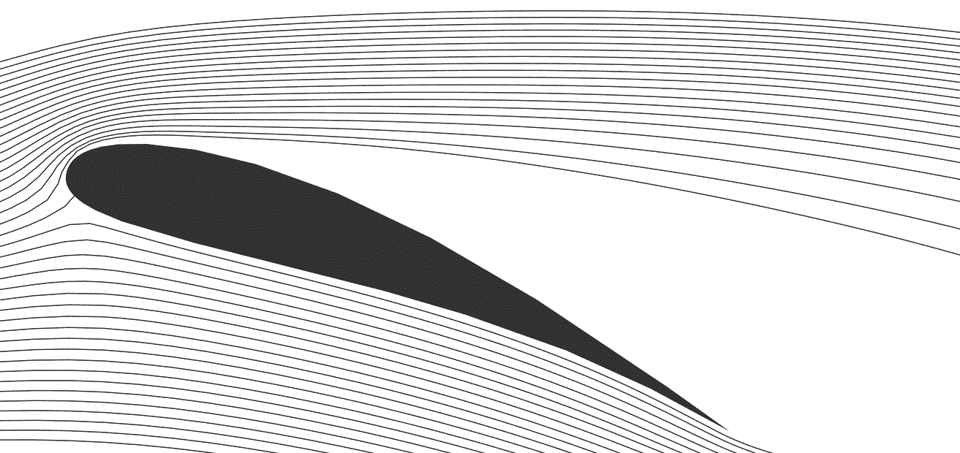Wing II - Physics #
This article is still a work-in-progress. Check back soon for a completed version.

C17 Globemaster III on takeoff. Photo courtesy of U.S. Air Force.
Introductory Thoughts #
Before diving in, it’s important to establish that the explanation for how a wing produces lift is one of the most contentious topics in physics. Incorrect explanations are abound, and truly rigorous explanations are by no means concise. This article attempts to hit the important peaks, striking a balance between accuracy and succinctness.
Physics of the Wing #
A wing functions by producing circulation, or a net turning of the flow, in the opposite direction to the force direction that is desired. For a lift generating wing, an upward force is produced as the the wing displaces the air downwards.
An Example…
The wings of a Boeing 747-400 cruising at 39,000ft move approximately 42 tons of air per second. (Figure courtesy of The Simple Science of Flight.
The alterations in the curvature of the streamlines manifest as changes in static pressure around the wing. This is seen below in the CFD images of flow over an airfoil. An airfoil is a 2D cross section of a 3D wing.

| Point | Behavior |
|---|---|
| 1. | The side of the airfoil producing lower than ambient static pressure is termed the suction surface. |
| 2. | The side of the airfoil producing higher than ambient static pressure is termed the pressure surface. |
As lift is just a consequence of deflecting air, there is nothing inherently special about an airfoil shape in regards to producing lift. Even a flat plate produces lift.

However, the difference arises in how efficiently each shape produces this lift.

The airfoil is much more efficient, as its streamlined shape (radiused leading edge, tapered trailing edge), displacing the flow with minimal total pressure loss.
The primary parameters influencing the circulation are camber & angle of attack.

| Point | Behavior |
|---|---|
| 1. | Camber - The extent of the asymmetry between the two and bottom surfaces of the airfoil. |
| 2. | Angle of Attack - Angle between the body’s reference line and the oncoming flow. |
Unfortunately, there is a fairly low ceiling on the maximum lift that is generated by tuning only these knobs. What does it look like when either the angle of attack or camber are overly ambitious?

The pressure surface does a commendable job of vertically displacing the streamlines, but, as a result of the ambitious curvature of the bottom surfaces leading edge, the boundary layer separates and flow is unable to stay attached.
The downward displacement of the streamlines is not nearly as impressive as the the orientation of the surface would imply.
Multi-Element Wing #
What is to be done to extract more circulation? A multi-element configuration is the most common method to increase the capability of a wing. These entails a chain of elements.

There are several mechanisms by which a multi element wing increases circulation.
Fresh Boundary Layer Effect #
Thin boundary layers sustain greater pressure gradients than thick boundary layers.

By contrast, on a single element wing with high angle of attack, the boundary layer very quickly thickens and separates.
Downstream Suction #
The trailing edge of the forward element is in a region of velocity higher than freestream. Therefore, the BL comes off of the forward element at a higher velocity. You don’t have to recover to Cp ~ .2 for the attached flow, relieving the pressure recovery demand.

Increased Camber & AoA of the Overall Assembly #
A multi-element wing has more aggressive camber and angle of attack by virtue of its design. Even without the slot, the more aggressive aseembly would produce more lift.

Through these effects, the multi element configuration produces much more circulation, as evident by the much higher vertical displacement of the streamlines.


This increased circulation is reflected in the static pressures surrounding the respective configurations.
Integrating the forces acting on each configuration tells an interesting picture.

- The efficiency of the single element is by far the best
- The absolute lift produced by the multi element configuration is highest
- The flap in isolation produces even even more lift than the mainplane, but at a large cost to efficiency.
Each of these geometries have their specific roles.
During cruising, efficiency is paramount in commercial aircraft. Therefore they have single element wings that minimize drag while providing enough lift to do their duty. However, during take off and landing, the aircraft needs to produce as much lift as possible to minimize the take off and landing distance (more lift means a lower speed that the aircraft becomes neutrally buoyant).
Therefore, to achieve both requirements, they deploy the multi element wings when taking off and landing, and cruise with a single element.

Boeing 747-400 landing. Photo courtesy of Adrian Pingstone.
Commercial airlines operate on razor thin margins and rely on volume to sustain their business model. So how does aerodynamic develop influence this?
From Boeing:
- A 0.10 increase in lift coefficient at constant angle of attack is equivalent to reducing the approach attitude by one degree. For a given aft body-to-ground clearance angle, the landing gear may be shortened for a savings of airplane empty weight of 1400 lb.
- A 1.5% increase in maximum lift coefficient is equivalent to a 6600 lb increase in payload at a fixed approach speed
- A 1% increase in take-off L/D is equivalent to a 2800 lb increase in payload or a 150 nm increase in range.
Therefore, doing the due diligence on the aerodynamics of an airplane makes or breaks the design financially.
Inverted Wing #
Racecars are designed with the same high-lift aerodynamic techniques, but for the opposite purpose. While aircraft use aerodynamics to take flight, racecars use their wings to maximize downward force into the ground to increase tire grip.

Red Bull RB14. Photo courtesy of Red Bull Racing.
